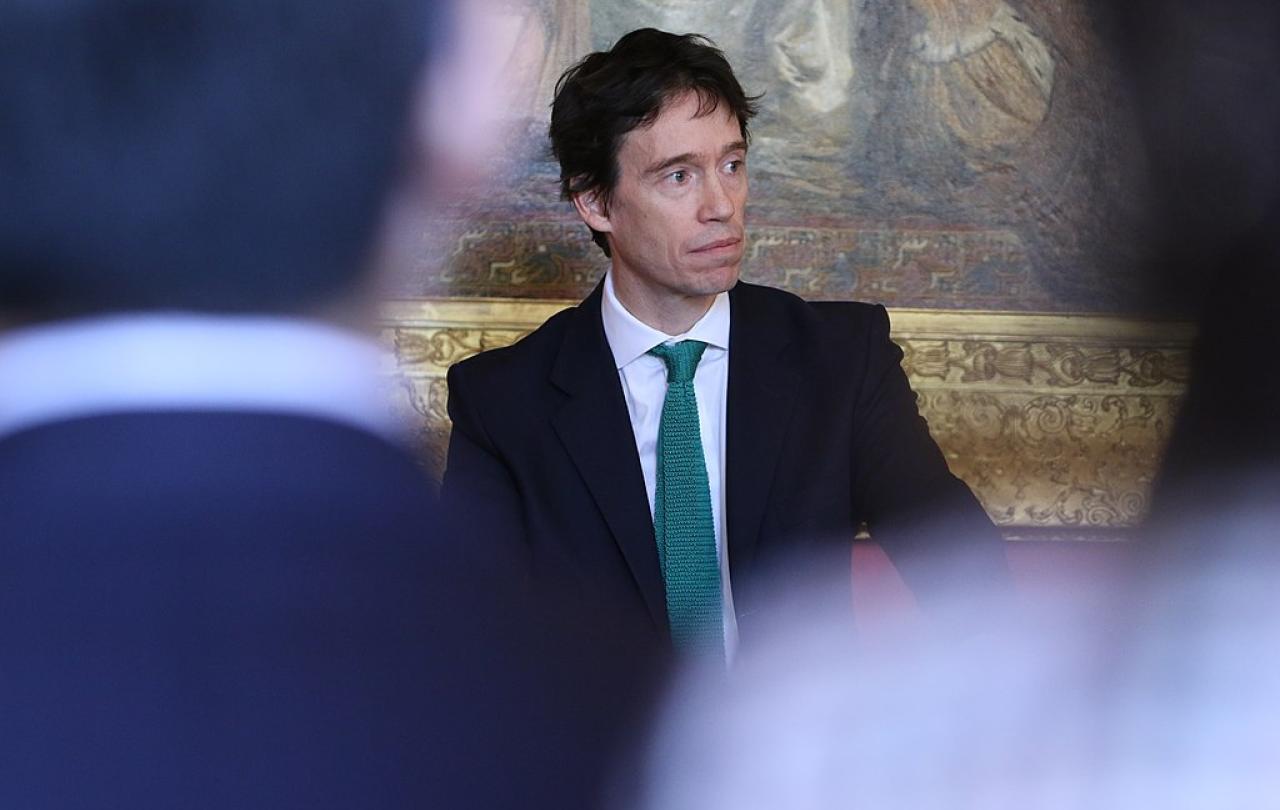
11/22/63 is Stephen King’s masterful alternative-history novel; crafting a world where JFK had not been assassinated. The Man in the High Castle is Philip K. Dick’s offering, painting the literary picture of a world where the so-called ‘Axis States’ won WWII. And then there’s Kim Stanley Robinson who imagines what the past five centuries may have looked like had 99% of the European population been wiped out by the Black Death (as opposed to the far more factual 35%) in The Years of Rice and Salt.
These books re-imagine the past, the present, and the future through the lens of two expansive words: what if.
While reading Rory Stewart’s Politics on the Edge, I found myself constructing an alternative present, one where Rory Stewart is our Prime Minister. Now, I’m not comparing the 2019 Conservative Leadership Contest to the Black Death (although, it’s a little tempting), nor am I comparing myself to Stephen King. It’s just that those two words – what if – have been harassing me. What if Rory Stewart had won that contest?
Where would our relationship with the EU currently stand? How might the heights of the Pandemic have been handled? And how might our country have recovered from it differently? What about the refugee crisis? The economy? The war in Ukraine? The war in Artsakh? The climate crisis?
How would these things be different, for better or for worse, if Rory Stewart wasn’t currently the politically-exiled co-host of (the ridiculously successful) The Rest is Politics podcast, but was instead our head of Government? I don’t hold the answers, just a large heap of curiosity.
It’s a foolish kind of curiosity though, because Rory Stewart was never going to be our Prime Minister. And he’s generously offered us a 417-page-long explanation as to why.
The book is magnificent. There’s no two ways about it. Annoyingly, Rory Stewart can add ‘natural wordsmith’ to his impressive assemblage of titles.
At the age of just 37, Rory could already call himself an Oxford graduate, a soldier, an author, a long-distance walker (admittedly this title doesn’t sound as interesting as the others, but I assure you that it is), a Governor of a province in Iraq and a Harvard Professor. Surely these achievements meant that he already had material enough for six pretty interesting memoirs. But Rory had his sights set on the British political arena, which I suppose is a natural aspiration for a man who recalls that,
‘the only thing that had ever really motivated me since I was a small child was the idea of public service’.
With the benefit of a decade worth of hindsight, such a line makes you want to scream ‘DON’T DO IT RORY’ into the page. You can’t help but pre-emptively wince at the inevitability of this man’s naïve heart shattering, can you? After all, these words sit forebodingly in Chapter 2.
But, scream at the book all you want, a bright-eyed Rory Stewart walked into Parliament in 2010. And that’s where this tale of an eccentric, well-meaning, albeit overly romantic, ‘boy-ish man’ (his words, not mine) becomes ‘an excoriating picture of a shamefully dysfunctional political culture’ (Rowan Williams’ words, not mine).
The book is magnificent. There’s no two ways about it. Annoyingly, Rory Stewart can add ‘natural wordsmith’ to his impressive assemblage of titles. He doesn’t simply re-call his experiences, he re-crafts them. This means, for example, that instead of his first encounter with David Cameron reading like a download of the meeting’s minutes; readers are treated to knowing that Cameron was late, that his smile was notably ‘easy’, his hair notably ‘fine’, and his understanding of the situation in Afghanistan notably limited. We also get to smugly enjoy that he began the meeting (in Kabul) with a naff joke about William Hague that had tumble weeds rolling across the international boardroom. We relish this while pretending, of course, that we haven’t had those excruciating moments ourselves, which we all have, just with the luxury of not having Rory Stewart in the room. Rory’s writing abilities invite readers into those rooms and those moments, all of which are usually out-of-bounds. Which brings me onto the second reason why this memoir is an utterly gripping read: it holds almost nothing back.
Rory places his former bosses (who just happen to be our former Prime Ministers), former colleagues, and friends – many of which I worry will also be in the ‘former’ category once they read of their appearances in this memoir – on the alter. He sacrifices any confidence that they may have once held in him in the name of necessary exposure. He pre-empts their rage, simply responding that
‘Our government and parliament, which once had a reasonable claim to be the best in the world, is now in a shameful state… and generally, given the choice between discretion and honesty, I have chosen the latter.’
His most brutal exposures (although I don’t doubt that many will argue that ‘exposure’ is an unfair word to use here, seen as we only have one unverified account of things that happened) are that of David Cameron, Liz Truss and, of course, Boris Johnson (Theresa May actually comes off rather well in comparison).
David Cameron comes across as a factory-made career politician; with learnt confidence and charm, rigidly rehearsed opinions, and an ensemble of old Etonians ‘with floppy hair and open-necked white shirts’ at his side. Rory’s depiction of Liz truss, on the other hand, can be adequately summed up in his recounting of one particular instance. After telling her that his father had just died, Truss ‘paused for a moment, nodded, and asked when the twenty-five-year environment plan would be ready.’ And then, of course, there’s Rory’s ultimate archnemesis – Boris Johnson - who appears to be the epitome of everything that Rory Stewart believes to be toxic and shameful about the current state of British politics. He is ‘ever the punchline,’ the man who, upon hearing the outcome of the Brexit referendum, advised Rory that he ‘mustn’t believe a word I am about to say’ before ambiguously offering/un-offering him a position in his cabinet. A cabinet which did not yet exist, of course.
And that’s not to mention his opinions of Micheal Gove – who somehow comesoff even worse than Boris. The characterisations in this memoir are blistering, to put it mildly. All heroes need a villain, after all. And Rory considers these villains to be ‘senior enough to bear responsibility’.
Reading this book, and enjoying it, is a disconcerting experience. One cannot help but lap up the drama, while simultaneously despairing over it. It is a great read, but I don’t want it to be. I don’t want a book this scandalous, with characters this toxic, and storylines this riveting, to be about the place and people who govern my country, and therefore, me. Of course, the book is not wholly damning. Rory assures us that there were/are people within the system that genuinely do their best for the sake of public service – but they’re fighting against the tide. On the whole, it’s a bleak (albeit enthralling) picture that Rory paints.
Genuine virtue, humble introspection, and noble altruism are no longer workable attributes. Public service for public service’s sake will not get you the top job.
So, back to those alternative history ponderings. How would, how could, Rory have changed things from the top of the pyramid? The King of the Middle-Ground. The Voice of Reason. The Hope of the Centrist. What would it look like for him to have had his way?
Frustratingly, it doesn’t much matter – because, as I say, this man was never going to be the UK’s Prime Minister. Not wholly because of any one individual, or any one leadership campaign, but because if (and we must bear in mind that it’s a big if) Rory’s perception of high office in Parliament is accurate – there’s no place for someone like him. Authentic humanity, in all its varying forms, is unexpected, unappreciated, and certainly unwelcome in those spaces. According to this book, genuine virtue, humble introspection, and noble altruism are no longer workable attributes. Public service for public service’s sake will not get you the top job.
And that is the true tragedy at the heart of this memoir. The book that I revelled in. The book that I wish didn’t exist.
Oh, that future Rory Stewarts would leave a decade of politics with nothing interesting to write about. One can dream, I suppose.





